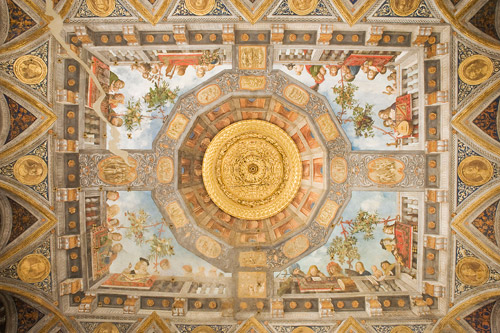
The Treasure room, perhaps originally intended for as a music room or a library, archive or thesaurus (place of collection of artwork and precious objects) is the best known room of the Palazzo Costabili palace, decorated between 1503 and 1506 by Benvenuto Tisi called Il Garofalo, one of the most important representatives of the Renaissance school School of Ferrara. A series of extensive renovation works brought back the frescoes to their the original brightness. of its colors.
In the course of the last two centuries the chronicles inform report of the greatnd interest for the artistic values of the hall, but also the concern for its preservation. From 1878, after even being used as a woodshed, important deformation in the masonry vault were visible, as well as cracking cracks on the ceiling caused by heavy burden. Interventions in the twenties reinforced and re-plastered the painted surface with cement-based mortar.
A historical-archivist research and preliminary diagnostic in 2005-2008, resulted in the static and structural consolidation of the vault and a complete restoration of the pictorial surfaces.
Looking up, at the ceiling of the Treasure Hall, the visitor finds himself in front of an exceptional spectacle of decoration: a daring prospective perspective that leads the view from the lower parts upward was inspired by the famous Camera degli Sposi painted by Andrea Mantegna in the Ducal Palace near in Mantua.
Along the sides of the ceiling a large balcony it´sis painted, a large balcony where Oriental rugs are hanging out: a gallery of characters, many of them which with musical instruments, leaning from the balcony to and show the observers their love for the arts, music and poetry. The ceiling is almost a showcase of the aristocracy of the time with portraits of rare elegance. In an evocative scenography, behind the balcony, a turquoise sky opens behind, with a gazebo filled with branches of fruit, knotted around the balustrade. This room is, in fact, a hortus conclusus, a secret garden realized carried out by the owner for his notable guests.
At In the center of the illusionistic opening there are a magnificent rose window in carved and gilded wood, and a painted architecture that serves both as a decoration and as a cover. There is alsoAll around runs a frieze that goes all around the room, with grotesque medallions depicted with scenes taken from mythology and stories of ancient Rome. The paintings of the ceiling painting was were linked to the walls around 1517, along with the decoration of sails, pendentives and lunettes that represent the myth of Eros and Anteros, a literary piece of by the humanist Celio Calcagnini, a close friend of Costabili, that choose his work to inspire Garofalo and his collaborators.